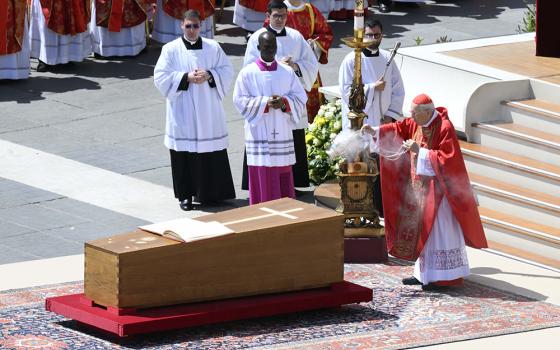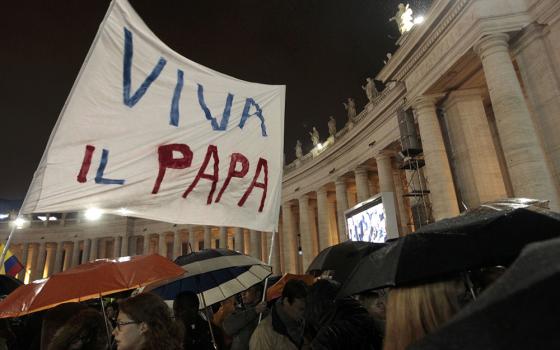The initial excitement about the selection of a new pope has died down, CNN no longer has cameras trained on the chimney at the Sistine Chapel or the loggia of St. Peter's. The astonishment at the choice of an Argentine cardinal and even greater astonishment at that Argentine’s choice of name, is still sinking in. And, we all continue to bask in the glow of the warm reactions to Pope Francis’ desire for greater simplicity in his personal circumstances, such as where he lives and what he wears, and his evident spiritual generosity, displayed in the silent blessing he offered to a room full of journalists many of whom were not Catholic, and even more so, in his decision to celebrate the Mass of the Lord’s Supper at a prison for youth.
The question remains, however, about reform in the Church. Clearly, from the interviews with cardinals both before and after the conclave, this was at the top of the agenda, but reform can mean different things to different people. Obviously, the pope is not going to wake up tomorrow and end clerical celibacy, or announce he will be ordaining women or presiding at the marriage of same-sex couples: He is aware, as most people with eyes to see are aware, that these last two issues have torn the Anglican communion apart and there is no reason to think it would be different with us Catholics. He understands, too, that maintaining the unity of the Church is the very essence of his ministry, not advancing this or that cause. The issue of clerical celibacy is different, lacking a doctrinal formulation, but I fear that if priests were allowed to marry, the first time one ran away with a secretary and left the parish to care for his ex-wife and children, many would be pining for the “good ole days of celibacy.” What is more, I do not think anyone can look at our culture today and not conclude it is over-sexualized and that the witness of celibacy has never been of greater value.
For most of the cardinals, it appears that the reform they were after was a reform of the curia. Even here it is not clear what is meant. There is no doubt that the curia is sometimes seen as an incubator for the clerically ambitious, but there are also many staffers there who work hard because they love the Church and want the Petrine ministry to succeed and don’t give two hoots about whether or not they become a cardinal. Human nature being what it is, I am not sure any structural reform will remove the oxygen ambition needs to survive. At the end of the day, a spiritual malady like ambition needs a spiritual cure, and spiritual cures cannot be dictated by a structural reform. I do think, however, that if the curia follows the pope’s lead and adopts more simple tastes, the posts will be less attractive to those who ambitions are confined to desiring personal pomp. I am told that cappa magnas are going at firesale prices these days. That is a good thing. We do not need more prelates whose ambitions include visions of watered-silk.
The key thing, it seems to me, that needs to change is the relationship between the “curia” and the “apartment.” The latter term refers to the rooms on the top floor of the Apostolic Palace, now still empty as Francis has chosen to live at the Domus Sanctae Marthae. But, the term “the apartment” refers, in reality, to the pope and his closest collaborators and what needs to change is the way they interact with the curia. I am all for obedience in the life of the Church, but the new pope must devise ways to encourage discussion and debate within the governance of the Church, instead of relying on some monsignor from the “apartment” simply saying, “Well, the Holy Father wants…” which may be the case but which is not an argument. In short, the place needs management, something it has not really had since Paul VI, indeed, I am told that some at the curia had hoped whomever was elected would take the name Paul as an indication of their commitment to governing. Paul knew how to make the place run, he knew whom to consult, he knew how to confront and deflate opposition, etc. I will go to my grave believing his was perhaps the most successful papacy of the 20th century, with Pius XI as a close runner-up.
There are a variety of ways to change the relationship of the “curia” and the “apartment” and, indeed, between Rome and the universal Church. Many cardinals expressed their disappointment with the General Congregations held before the conclave. Speech after speech after speech, with no give and take, no Q & A, no digging deeper into any issue. The speeches became repetitive. The whole process reflected badly on the curial cardinals. But, that is also exactly what a Synod of Bishops looks like, a series of endless speeches with no digging down into the issues. By “digging down” what I mean is simply this: Sometimes, I hear a cleric denounce “secularization” or speak glowingly about the “New Evangelization” and I get the suspicion that it is just a bumper sticker to them, that the person speaking uses these words because he has heard them before, but can’t really explain, because he has not really considered, just how complex a process like “secularization” is. If meetings at the Vatican allowed for give and take so that these ideas could be fleshed out, and the bumper sticker bishops be exposed for their shallow grasp of the issues, much would be accomplished.
Similarly, it is time to set the Reset button on the ad limina visits. This is Vatican kabuki theater at its worst. Every five years – it stretched to seven recently – bishops go to Rome, meet with the various dicasteries and with the Pope himself. He is seated on a throne at one end of the room and the bishops from a given geographic region are sitting in a row, like altar boys, facing each other and looking up at the pope. He gives a speech, which would have been drafted by the Secretariat of State, which probably consulted with the bishops who are actually sitting there in advance. It is all staged beautifully, what where in this process does the pope really learn about what is going on in the Church in this or that region? Mightn’t these meetings be better conducted at a conference table, with no speeches, just an informal give-and-take among brother bishops with their pope? Why does the pope not meet with his own curia members at conference tables with some regularity? Sometimes, the smallest changes reap the biggest rewards, and nixing the papal throne and introducing some conference tables into the “apartment” might change the entire way the place is run.
Of course, I do not want the new pope to get too bogged down in these kinds of issues. One of the best things he has said so far is his warning against the Church becoming too self-referential and institutional reform requires a lot of nasal-gazing to be effective. And, Pope Francis’ accessible personal style may go a long way towards inviting the kind of information he needs to make the changes the cardinals wanted in selecting him. I worry that his decision to stay at the Vatican Hotel could backfire, as people scramble for access. But, I also like the idea of his interacting with those who work at the Vatican and live there year-round. You can learn a lot over a casual lunch: Is this person happy? Do they discuss their work in a way that evidences they find it fulfilling or frustrating? Why is this person so nervous? No matter how structures change, an organization needs the right people in it. To this end, I repeat my call for some equivalent of a Vatican personnel board, a group that conducts evaluations, actually asks employees what they would like to do, and gets away from the idea that a network of friendship and patronage should determine how moves up the bureaucratic food chain and who does not.
Tomorrow, I will take up this issue of reform again.





